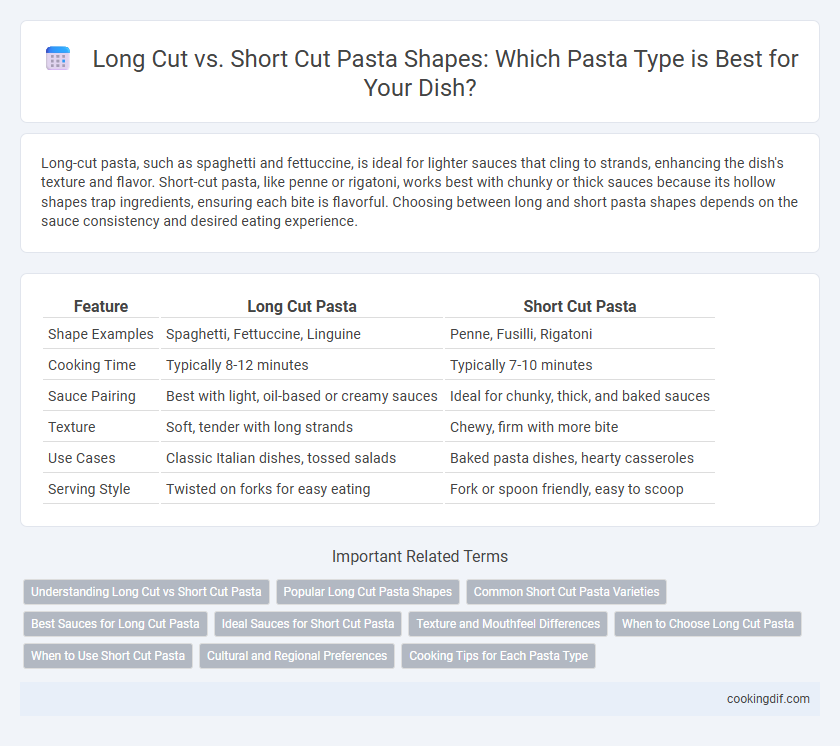Long-cut pasta, such as spaghetti and fettuccine, is ideal for lighter sauces that cling to strands, enhancing the dish's texture and flavor. Short-cut pasta, like penne or rigatoni, works best with chunky or thick sauces because its hollow shapes trap ingredients, ensuring each bite is flavorful. Choosing between long and short pasta shapes depends on the sauce consistency and desired eating experience.
Table of Comparison
| Feature | Long Cut Pasta | Short Cut Pasta |
|---|---|---|
| Shape Examples | Spaghetti, Fettuccine, Linguine | Penne, Fusilli, Rigatoni |
| Cooking Time | Typically 8-12 minutes | Typically 7-10 minutes |
| Sauce Pairing | Best with light, oil-based or creamy sauces | Ideal for chunky, thick, and baked sauces |
| Texture | Soft, tender with long strands | Chewy, firm with more bite |
| Use Cases | Classic Italian dishes, tossed salads | Baked pasta dishes, hearty casseroles |
| Serving Style | Twisted on forks for easy eating | Fork or spoon friendly, easy to scoop |
Understanding Long Cut vs Short Cut Pasta
Long cut pasta, such as spaghetti and fettuccine, provides a smooth texture that pairs well with light, oil-based or creamy sauces, allowing flavors to cling to their elongated surfaces. Short cut pasta shapes like penne and farfalle offer a hearty bite and trap chunky sauces or ingredients within their ridges and hollows, enhancing texture and taste. Choosing between long and short cut pasta depends on the sauce consistency and desired mouthfeel, optimizing the overall culinary experience.
Popular Long Cut Pasta Shapes
Popular long cut pasta shapes such as spaghetti, fettuccine, and linguine are favored for their ability to hold light to medium sauces like marinara, Alfredo, and pesto, enhancing the overall flavor experience. These shapes provide a versatile base for dishes including classic spaghetti Bolognese and creamy Fettuccine Alfredo, offering a satisfying texture that complements both simple and rich sauces. Unlike short cut pastas, long cuts tend to twirl easily, making them ideal for elegant presentation and traditional Italian recipes.
Common Short Cut Pasta Varieties
Common short cut pasta varieties like penne, fusilli, rigatoni, and farfalle are prized for their ability to hold sauces well due to their ridges and shapes. These pasta shapes offer versatility in dishes ranging from baked casseroles to hearty pasta salads, providing texture and surface area for robust flavors. Short cut pasta varieties are ideal for creamy, chunky, or oil-based sauces that cling to their grooves and hollow centers, enhancing every bite.
Best Sauces for Long Cut Pasta
Long cut pasta shapes such as spaghetti, linguine, and fettuccine best complement smooth, oily, or creamy sauces because their length allows for even sauce coating and a balanced bite. Classic pairings include tomato-based marinara, rich Alfredo, and olive oil-based aglio e olio sauces that cling well to the strands. The thin, elongated shape enhances the flavor absorption of lighter sauces, making these pastas ideal for dishes featuring seafood, garlic, and fresh herbs.
Ideal Sauces for Short Cut Pasta
Short cut pasta shapes like penne, rigatoni, and farfalle excel with chunky, hearty sauces due to their ridges and hollow centers that trap ingredients. These shapes complement meat-based ragus, thick tomato sauces, and creamy cheese blends, maximizing flavor adhesion and sauce coverage. Their compact size and texture make them perfect for baked pasta dishes and cold pasta salads, where sauce distribution and bite consistency are crucial.
Texture and Mouthfeel Differences
Long cut pasta, such as spaghetti and fettuccine, offers a smooth, continuous texture that enhances the mouthfeel by allowing sauces to evenly coat each strand, creating a delicate yet satisfying bite. Short cut pasta, like penne and rigatoni, provides a more varied texture with ridges and hollow centers that trap thicker sauces, resulting in a heartier and chewier mouthfeel. The choice between long and short cut pasta shapes significantly influences the tactile experience, with long cuts favoring elegance and smoothness, while short cuts emphasize robustness and sauce retention.
When to Choose Long Cut Pasta
Long cut pasta shapes like spaghetti, fettuccine, and linguine work best with lighter, thinner sauces such as olive oil, garlic, or simple tomato-based sauces, as they allow the sauce to coat the strands evenly. These shapes complement dishes with seafood, vegetables, or delicate proteins, providing a balanced texture and flavor experience. Choose long cut pasta when aiming for an elegant presentation or when incorporating ingredients that pair well with slender, elongated noodles.
When to Use Short Cut Pasta
Short cut pasta shapes, such as penne, fusilli, and farfalle, are ideal for thick, chunky sauces and baked pasta dishes because their grooves and tubes trap sauces effectively. Their compact size makes them perfect for salads and soups, providing a balanced bite with every forkful. Choose short cut pasta when you want a hearty, textured meal where the sauce and ingredients are evenly distributed.
Cultural and Regional Preferences
Long cut pasta shapes such as spaghetti and fettuccine dominate Italian coastal regions where they pair well with seafood and lighter sauces, reflecting local culinary traditions. Short cut pasta varieties like penne and rigatoni are favored in inland areas, often combined with rich, hearty sauces like ragu or meat-based preparations typical of northern Italy. These cultural and regional preferences influence cooking methods and sauce pairings, highlighting diverse Italian gastronomic heritage.
Cooking Tips for Each Pasta Type
Long cut pasta like spaghetti and fettuccine requires ample boiling time to achieve an al dente texture and benefits from stirring early during cooking to prevent clumping. Short cut pasta such as penne and fusilli cooks faster and retains sauce well due to its shape, making it ideal for baking dishes or hearty sauces. For optimal results, reserve pasta water to adjust sauce consistency and avoid overcooking either type to maintain their desired firmness.
Long cut vs short cut for pasta shape Infographic

 cookingdif.com
cookingdif.com